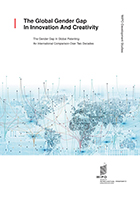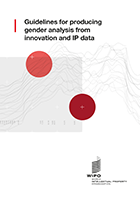Innovation Gender Gap: 4 Initiatives to Narrow the IP Gender Gap in the Americas
Considering the growing global recognition of the importance of gender and diversity disparities in innovation, several countries have taken steps to address these gaps. A group of delegates from the United States, Mexico, Chile and Colombia convened to highlight the policies and programs adopted within the Americas. Read about them here!

The United States of America
With the objective of promoting inclusiveness in innovation, invention and entrepreneurship across the United States of America, the United States Patents and Trademarks Office (USPTO) launched the Council for Inclusive Innovation in 2020. The Council convenes industry, academic and government leaders to support the development of a national strategy for increasing participation of women and other underrepresented groups in the United States innovation ecosystem. Council members engage in a number of work areas aiming to create, practice, realize, measure and monitor innovations.
Through the IP Patch Program, the USPTO also supports the future generation of inventors and entrepreneurs. As a joint initiative between the USPTO, the Girl Scout Council of the Nation’s Capital (GSCNC) and the Intellectual Property Owners (IPO) association, IP Patch raises awareness and interest among girls of all ages in creating and protecting intellectual property across science, technology, engineering and mathematics (STEM) fields.
Mexico
In 2018, Mexico submitted a Proposal on Women and Intellectual Property to the Twenty-Second Session of the WIPO Committee on Development and Intellectual Property (CDIP). The proposal aimed at drawing CDIP members’ attention to the importance of incorporating gender perspectives into intellectual property policies. It then led to a CDIP decision of stating a range of actions that WIPO member states could take to support women and girls' participation in the IP system. The decision also encouraged WIPO to continue increasing its assistance to women and girls through various platforms such as the WIPO Academy.
Chile
In 2021, Chile’s National Industrial Property Institute (INAPI) founded the Latin American Gender and Intellectual Property Network jointly with the intellectual property offices of Colombia, Costa Rica and Peru. With the objective of bridging gender gaps in intellectual property use, the network is providing a platform for intellectual property offices across the region to collaborate in fostering women participation in innovation and entrepreneurship. Currently, the network includes intellectual property offices from the following countries: Argentina, Brazil, Chile, Colombia, Costa Rica, the Dominican Republic, Ecuador, Mexico, Peru, and Uruguay.
Chile’s INAPI has also developed an internal Gender Policy that addresses action areas to empower women in using intellectual property and seizing innovation and entrepreneurship opportunities. Some of INAPI’s action areas include analyses on the participation of women in patents and trademarks applications. Through these studies, INAPI provides key facts and information on where the gender gaps are in the intellectual property system.
Colombia
Colombia has developed various initiatives that support women of all ages and backgrounds to participate in science, technology, innovation and entrepreneurship. One of these initiatives is a national entrepreneurship fund known as Fondo Mujer Emprende. The fund supports women entrepreneurs to turn their business ideas into reality by having more access to financing, customers and digital skills. Women-led businesses also receive support from two national legal instruments. One instrument is Colombia’s Act 2056 of 2020, which channels royalty resources towards entrepreneurship and innovation projects led by women from rural areas. The other instrument is Colombia’s Decree No. 1860 of 2021, which set out a differential criterion that favors the participation of women-led enterprises in government procurement.
Other initiatives are PorTic Mujer and Llegamos con TIC that provide women and girls with skills and competencies in using information and communications technologies (ICTs). In addition, Colombia’s +Mujer +Ciencia +Equidad Programme supports young women from diverse backgrounds with scientific vocations to have access to networks and training opportunities through the national science, technology and innovation system.
Do you want to know about other initiatives or programs in the world? Check our selection of gender-related policies.
Do you know about other policies that are not listed? Please feel free to contact us and we will be happy to add it!
Related Stories

Innovation Gender Gap: 4 Asian-Pacific Initiatives to Narrow the IP Gender Gap
As nations around the world become increasingly aware of the importance of gender and diversity gaps in innovation, many have implemented policies to reduce these gaps.

Innovation Gender Gap: 4 Initiatives to Narrow the IP Gender Gap in Africa and Arab regions
As nations around the world become increasingly aware of the importance of gender and diversity gaps in innovation, many have implemented policies to reduce these gaps.

Innovation Gender Gap: 5 Initiatives to Narrow the IP Gender Gap in Europe
Considering the growing global recognition of the significance of gender and diversity disparities in innovation, numerous countries have taken steps to address these gaps. A group of delegates from Spain, Poland, the United Kingdom, Lithuania, and Hungary convened to highlight the policies and programs adopted within Europe. Read about them here!
Related resources

The Global Gender Gap in Innovation and Creativity: An International Comparison of the Gender Gap in Global Patenting over Two Decades
This report analyzes women’s participation in international patent applications between 1999 and 2020 and finds that women are involved in only 23% of all applications, representing 13% of all inventors listed. Women’s participation in patenting varies across regions, sectors, and industries, with higher representation in biotechnology, food chemistry, and pharmaceuticals, and lower in mechanical engineering. Women inventors are more prevalent in academia than in the private sector, and typically work in mostly-male teams or alone. Achieving gender parity will require significant effort, with an estimated target year of 2061 based on current trends.

Guidelines for producing gender analysis from innovation and IP data
Understanding how women and men can access and use the intellectual property (IP) system equally is key to ensuring that their ingenuity and creativity translates into economic, social and cultural development. This short guide summarizes best practice for producing innovation and IP gender indicators.